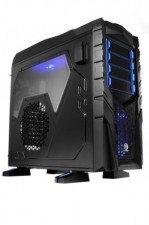 Never to be known as sitting idly by, Thermaltake continues to roll out new product after new product. One of their newest product offerings in the chassis line is the Chaser MK-1. The Chaser MK-1 is the first case offering in Thermaltake’s new “Galaxy Episode” series of products, so today we’ll have an in depth look at what this case has to offer you, the consumer!
Never to be known as sitting idly by, Thermaltake continues to roll out new product after new product. One of their newest product offerings in the chassis line is the Chaser MK-1. The Chaser MK-1 is the first case offering in Thermaltake’s new “Galaxy Episode” series of products, so today we’ll have an in depth look at what this case has to offer you, the consumer!
First a snippet about Thermaltake as taken from their website:
The Company Line
“We live in a world where most things seem to move at the speed of light. At Thermaltake, we feel the same way and that is exactly how Thermaltake conducts itself to deliver innovative, reliable and customer-centric solutions to the worldwide market.
Since the beginning of Thermaltake in 1999, it has been at the forefront of creating new and exciting products at a time where most computer users were provided little to no choices for components that may seem irrelevant, but in reality crucial to the performance of a PC.
While still a relatively young company, established in 1999, Thermaltake is built on unwavering will and dedication to address issues and innovate at the same time for computer enthusiasts and corporate users worldwide .
Customers are our greatest asset and Thermaltake does not take that for granted. That is why Thermaltake is the industry leading in customer service and customer support with around-the-clock automated product return service.”
As is the case with everything we receive from Thermaltake to review, the Chaser MK-1 arrived in perfect condition due to the superb packaging methods employed by Thermaltake. We have reviewed Thermaltake products both big and small, every one of which are packaged extremely well and arrive it tip top condition.
The chaser MK-1 box is very colorful and vibrant looking. A blue galaxy of stars and an image of a female warrior with a monster of some sort behind her grace the front of the box, an obvious attempt at letting the potential customer know this is a gaming case. There is also a picture of the MK-1 itself on the front of the box and two adverts mentioning both the internal USB 3.0 and the “extra big ATX tower” design.
Moving around to the sides of the box, the left side has another picture of the MK-1 and some branding. The right side of the box lists a few of the highlighted features in a multilingual format.
The back of the box has a couple large pictures describing the air cooling flow and the water cooling applications available. Numerous thumbnail pictures describe the internal and external structure design as well as a few of the MK-1’s unique qualities.
 |
 |
 |
 |
Features |
|
| Command Center | With Chaser MK-1’s fan controller onboard, gamer and enthusiasts can appreciate the convenience of adjusting the fan speed or lighting effect of the computer system. |
| USB 3.0 SuperSpeed | Tired of reaching to the back of the computer to connect a USB 3.0 device? Chaser MK-1 features latest USB 3.0 ports with internal header. Two USB 3.0 ports are conveniently located on the front of the case. |
| HDD Docking Station | By adapting world’s best selling BlacX Docking Station concept into a computer case, users can now effortlessly transfer large volume of data without the need for a conventional external storage device. Simply insert any 2.5 or 3.5 SATA hard drive into the docking station and start enjoying hot-swap capability and blazing-fast transfer speed through SATA interface. |
| VGA TripleMax 33CM | All of today’s high-end and advanced graphic cards that are capable of delivering ultra-realistic, immersive and intense gaming experience have longer than usual form factor which means not all computer case will fit. Chaser MK-1 not only address this concern by supporting graphic card up to 330mm in length, but also designed cooling surrounding the graphic card location to improve heat dissipation and reduce acoustic output. |
| CableClear Cable Management | Dramatically improves thermal efficiency of the computer system by ensuring power cables do not get in the way of airflow. |
| Enthusiasts Water Cooling Ready | Spacious interior is only the bare minimum when it comes to water cooling. Chaser MK-1 features an innovative top removable panel that can be easily transformed to accommodate high-efficiency 24cm radiator! |
| Combat Headset Holder | Headset holder designed into the case allows gamers to store their gaming headset easily and securely. |
| Heightened Foot Stands | High thermal efficiency case that address all common and uncommon issues. Heighten foot stands elevate the whole computer system enough to prevent rug or any other soft flooring material from blocking the air intake/exhaust found on the bottom of the case. |
Specifications |
|
| Case Type | Full Tower |
| Material | SECC |
| Front Bezel Material | Combination of plastic and high air flow mesh |
| Color | Interior: Black Exterior: Black |
| Side Panel | Swivel Door with Transparent Window |
| Motherboard Support | 9.6″ x 9.6″ (Micro ATX) 12″ x 9.6″ (ATX) |
| Removable Motherboard Tray | No |
| 5.25″ Drive Bay | 4 |
| Ext. 3.5″ Drive Bay | By using 5.25″ to 3.5″ Converter |
| Int. 3.5″ Drive Bay | 6 |
| Expansion Slots | 8 |
| Front I/O Ports | USB 3.0 x 2 USB 2.0 x 2 eSATA connector x 1 MIC & Speaker (support AC97 & HD Audio) |
| Cooling System | Front (Intake) : 200 x 200 x 30 mm Colorshift fan x 1 (600~800rpm,13~15dBA) or 120 x 120 x 25 mm x 2 (optional) Rear (Exhaust) : 140 x 140 x 25 mm TurboFan 1000rpm, 16dBA or 120 x 120 x 25 mm x 1 (optional) Top (Exhaust) : 200 x 200 x 30 mm Colorshift fan x 1 (600~800rpm, 13~15dBA) or 200 x 200 x 30 mm x 1 (optional) or 140 x 140 x 25 mm x 2 (optional) or 120 x 120 x 25 mm x 2 (optional) Bottom (Intake) : 120 x 120 x 25 mm x 1 (optional) Side (Intake) : 200 x 200 x 30 mm x 1 (optional) |
| Liquid Cooling Capable | Yes |
| Liquid Cooling Embedded | No |
| Power Supply Supported | Standard ATX PSII Power Supply |
| Power Supply Included | No |
| Dimension (H*W*D) | 567.9 x 237.0 x 581.6 mm 22.4 x 9.3 x 22.9 inch |
| Net Weight | 12.3 kg 27.1 lb |
| Security Lock | For peripherals only |
| Application | Suitable for gaming, enthusiast, DIY and modding |
We’ll start our exterior tour of the Chaser MK-1 by beginning at the left side panel. Three main features are present here, the large plexi-glass window, the headphone holder and the large mesh area which has the option of installing a 200mm fan.
The right side of the MK-1 is void of any ventilation but does employ some design attributes by way of the stamping used. The large center stamped area is raised higher than the outer edges of the panel, thus allowing for additional cable management space.
Moving along to the back of the Chaser MK-1 we find several key features. Starting at the top you will find three rubber grommets intended for a water cooling system tubes to pass through. Just below that is a 140mm exhaust fan which has an option to be swapped out for a 120mm fan. To the left of the exhaust fan is the opening where the motherboard’s I/O shield gets installed. Moving down we see the eight expansion slot covers and a large ventilation area just to the right of that. The standard ATX power supply mounting area is found a the bottom along with a slide out PSU filter. The filter slides out extremely easy by just pressing down on the tab and sliding outward.
Flipping the case over so we can have a look at the bottom, we will find the four extra large feet. The feet can be rotated in a complete circle and will click/lock in to place every 22.5 degrees. The MK-1 offers a unique design feature for the foot stands, they are taller (35mm) than what you normally find on other cases. This feature is intended to allow unobstructed air flow for the power supply, even if the chassis is place on a soft or carpeted surface. We did find one troubling issue with the foot stands, and that is the lack of any rubber cushioning. What ever surface you set the MK-1 on, it will be subject to the hard plastic design of the foot bottom and thus offer no anti-vibration qualities.
 |
 |
 |
|
 |
 |
 |
 |
 |
 |
As we finish up the exterior tour of the Thermaltake Chaser MK-1 we’ll hit on the areas where you will be spending most of your time while using the case, the top and front panel areas. Beginning at the front of the MK-1 the fist thing you might notice is the light blue accents applied to the drive bay covers. The light blue coloring is present in several different areas as you navigate your way around the MK-1, including the interior which you will see later in the review. We found the blue accents to be quite appealing actually and they are definitely a break from the typical Thermaltake red accents used on most of their other cases.
There are four 5.25 drive bay openings, one of which can be converted to a 3.5 bay using the included adapter cover. All of the drive bay covers have a mesh design and a foam filter applied to the back side. Removing any of the 5.25 covers is pretty straight forward, a simple inward squeeze of the two light blue handles and the cover will come right out.
Below the 5.25 bay covers is a large mesh area with a 200mm intake fan just behind it. Rounding out the front bezel area is a nice chrome looking Thermaltake branding decal.
 |
 |
 |
|
The top panel area of the Chaser MK-1 is where all connectivity points and fan functions are located. Beginning on the left side you have the fan LED color control button, the fan speed control buttons (600rpm or 800rmp), reset button and a mic and headphone jack. The color of the fan LED’s can be cycled between blue, green, red and a mixture of all three. On the right side of the top panel are two USB 3.0 ports, one e-SATA port and two USB 2.0 Ports. In the middle of the top panel is where the Thermaltake decided to implement a hot swappable hard drive docking station similar to their popular BlacX HDD enclosure products. The hot swap drive bay will accommodate both 3.5 and 2.5 HDD’s. To use the hot swap drive bay is a very simple procedure and only requires sliding the drive in place until you feel the reassuring click confirming the connections have been properly seated. Also located in the center portion is the power switch which is surrounded by a clear plastic inset. The plastic inset illuminates when the system is started and slowly pulsates on and off while the system is running.
The rear portion of the top panel is a mesh design and has a single 200mm fan beneath the rear most area. Further complimenting the design of the top panel are two light blue accent strips running down both sides. While there is no foam style fan filter, the design of the mesh area is two stage with the inner layer being a more tightly woven mesh, almost screen like. The combination of both the inner screen and outer mesh should do an adequate job of filtering the air before it enters the case.
 |
 |
 |
 |
 |
 |
 |
|
As is usually the case with the look of Thermaltake’s chassis, you either love it or hate it. The rugged looks of the Chaser MK-1 may or may not appeal to you, but you have to give Thermaltake it’s props for consistently throwing new design concepts out to market. We’ll admit that the looks of the Chaser MK-1 grew on us the more familiar we became with it. If we had to compare it to something, the CoolerMaster HAF-X or HAF-932 cases come to mind, although not quite as large. The Chaser MK-1 falls right in the middle of a mid tower and full tower designs, hence the mention of “Extra Big ATX Tower” on the packaging.
Next up is a closer look at the interior.
We begin our interior tour by removing the right side panel and having a look behind the motherboard tray and drive bays. To remove either side panel requires only the removal of an upper and lower thumbscrew located on the back of the case. Once the thumb screws are removed the panels swing open by pivoting at the front of the panel, then simply slide off. Immediately noticeable upon removal of the right side panel is the huge access hole which is terrific for getting at the back side of a CPU cooler, thus eliminating the need to remove the motherboard from the case to perform a swap out of a CPU fan or water block. You can also see the five large rubber grommets used to route all the cabling behind the motherboard tray and out of sight. Nicely organized and wire tied together are all of the MK-1’s top panel connection harnesses. There are two SATA cables (one for eSATA and one for the HDD dock), the USB 3.0 motherboard header cable and the USB 2.0 motherboard header cable. Additionally the usual power switch/LED connection cables, HD/AC97 audio cable and power leads for the fans are all located here. The other thing we wanted to mention is the distance between the back of the motherboard tray and the right side panel. There appears to be a slight increase in this distance compared to other Thermaltake offerings we have reviewed (and complained about) in the past.
 |
 |
 |
 |
 |
 |
 |
 |
 |
|
Turning our attention to the top it was necessary to remove the panel in order to get a good look at what is beneath it. The design used to remove the top panel is very simplistic and a pleasure to deal with. I don’t think we have ever come across another case where the top panel was removed quite this easily. All that is required is to lift it up from the rear grab handle and it easily separates from the main body. Once removed you get a good look at the 200mm exhaust fan and the additional option to add another. The fan mounting apparatus affords the opportunity to swap out the 200mm fan in favor of either a 140mm or 120mm solution. Not to be overlooked is the ability to mount up to a 240mm radiator here as well. If you like an abundance of cooling options, there are plenty to be had in this area of the MK-1.
 |
 |
 |
 |
 |
|
Exploring the main cavity of the Chaser MK-1 will be our next adventure. When looking inside the this area for the first time you will find a box of accessories tied to the motherboard tray. Below is a list of what is included in the accessory pack:
- Users Manual
- 8-Pin CPU Power Cable Extension
- 5.25 to 3.5 Bezel Adapter
- Internal 5.25 to 3.5 Adapter Tray
- Wire Ties
- Four Packages of Various Screws
- Speaker Cable
Something worth mentioning about the internal 5.25 to 3.5 bay adapters is that it does not have an option to mount a device from its side, only from the bottom. If you have a card reader or similar device that only has threaded holes on the sides for mounting it, then you will need to buy a different adapter to make it work.
 |
 |
The two pictures below will give you an idea of the large area available to work with as you assemble a system to the MK-1. The cable management holes are located in just the right spot to route wires behind the motherboard tray and back to the motherboard connection points. Down at the bottom you will notice a PSU support bracket which can be moved forward or back to work with any size unit. One thing missing from the PSU support bracket is a rubber strip along the portion that the power supply rests on, which would help prevent vibration. The motherboard mounting pegs are pre-installed, but you will want to double check to make sure they align correctly with your motherboard’s configuration. Worth noting is the option to mount a 120mm fan at the bottom just in front of the PSU area.
 |
 |
The next few pictures show the rear of the interior where the 140mm exhaust fan is located. The rear exhaust fan utilizes a three pin braided power lead to match up to a motherboard’s fan header. The eight expansion slot covers are held down with black thumb screws at all locations making removal of add-on cards a snap.
 |
 |
 |
|
The top interior features the previously mentioned 200mm fan and the open fan bay for an optional 200mm, 140mm or 120mm fan.
 |
Moving around to the front of the interior we see the 5.25 and 3.5 drive bay mounting areas. Both the 5.25 and 3.5 bays utilize a very unique and easy to use drive mounting system (more on this later). The six plastic 3.5 drive bay trays are made with the same light blue color scattered about the Chaser MK-1. The four 5.25 drive bay locking levers are also colored in the light blue theme.
 |
 |
 |
 |
 |
|
Installing an optical drive into a 5.25 bay is just a matter of removing a bay cover, sliding the drive into the bay opening and feeling click/lock in place. As you slide the drive in you will see the locking lever raise outward until such time as the holes are aligned. Once the holes are aligned the lever snaps back down securing the drive. You have the option of adding additional screws from the opposite side to further secure the drive in place.
 |
 |
To install a hard drive in one of the trays entails releasing the spring tension on the lever and swinging it open. Once the lever is released the tray will slide out the front easily. There is a clip on each side of the tray that will need to be removed before setting the drive in the tray. After the clips are removed, you lay the HDD in the tray so the holes line up where the clips were, then simply push the two clips back on the tray to secure the drive. The hard drive trays also have holes in the base that will accommodate a 2.5 drive should mounting a SSD be required.
 |
 |
 |
 |
To conclude our interior tour we’ll have a look behind the front bezel, which is easily removed by grabbing it at the bottom and pulling straight outward. The first picture below is of the back side of the front bezel and gives you a good look at the foam filters utilized by the 5.25 drive bay covers. Once the front bezel is removed you can see the screen mesh filter used over the front 200mm intake fan. The filter located here is easily removable by pressing two tabs located on the left side of it. The front intake 200mm fan is behind a mesh area with good sized perforated holes allowing for good air flow.
 |
 |
 |
|
The Thermaltake Chaser MK-1 has a very unique, rugged and aggressive look to it that should appeal to most gamers out there. I do not consider myself much of a gamer, but I actually fell hard for the looks of this case, so much so I decided to use it for my own home server, which was in dire need of a case upgrade. The list of features on the Chaser MK-1 seem endless with a multitude of cooling options, the color shift fans, abundant interior space, built in HDD dock, USB 3.0 support, etc., etc. The Chaser MK-1 feels very sturdy and well built while handling it, the only caveat being that the top panel will separate from the main body if you grab it in an attempt to move the case around. A small price to pay for the convenience of an easily removable top panel in our opinion. Below are some pictures of my home server assembled in the Chaser MK-1 and some additional shots of the lighting. The mATX motherboard I use in my home server is simply dwarfed by the large amount of room inside the case but hopefully you will get a concept of the roominess.
 |
 |
 |
 |
 |
 |
 |
 |
 |
 |
 |
 |
At the time of this review the Thermaltake Chaser MK-1 is selling for around $160 USD, which is in line with similar offerings from other manufactures. However there are options the Chaser MK-1 has that the competition does not, such as the HDD docking bay and the USB 3.0 internal connection, making it an even better value.
Pros
- HDD Docking Bay
- USB 3.0 Support
- Tremendous Amount of Interior Room
- Rugged Looks
- Abundance of Cooling Options
- Color Shift Fan Feature
- Easy Drive Mounting Systems
- Extensive Cable Management Options
- Support for Graphics Cards up to 13″ Long
Cons
- No Rubber Cushioning Feet
- No Rubber Cushioning on PSU Support Bracket
- No Side Mount Screw Option on the 5.25 to 3.5 Internal Bay Adapter
If you are looking for a gaming case that packed with features, rugged looking, has more than adequate room to house all of your components and all the while keeping everything cool, then the Thermaltake Chaser MK-1 may be exactly what you are looking for. Overclockers Tech has given the Chaser MK-1 a 9/10 and the accompanying gold award!






 Posted in
Posted in 

